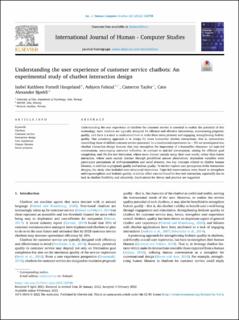| dc.contributor.author | Fornell Haugeland, Isabel Kathleen | |
| dc.contributor.author | Følstad, Asbjørn | |
| dc.contributor.author | Taylor, Cameron | |
| dc.contributor.author | Bjørkli, Cato | |
| dc.date.accessioned | 2023-08-31T15:15:41Z | |
| dc.date.available | 2023-08-31T15:15:41Z | |
| dc.date.created | 2022-05-20T11:25:01Z | |
| dc.date.issued | 2022 | |
| dc.identifier.citation | International Journal of Human-Computer Studies. 2022, 161, 102788. | en_US |
| dc.identifier.issn | 1071-5819 | |
| dc.identifier.uri | https://hdl.handle.net/11250/3086679 | |
| dc.description.abstract | Understanding the user experience of chatbots for customer service is essential to realize the potential of this technology. Such chatbots are typically designed for efficient and effective interactions, accentuating pragmatic quality, and there is a need to understand how to make these more pleasant and engaging, strengthening hedonic quality. One promising approach is to design for more humanlike chatbot interactions, that is, interactions resembling those of skilled customer service personnel. In a randomized experiment (n = 35) we investigated two chatbot interaction design features that may strengthen the impression of a humanlike character: (a) topic-led conversations, encouraging customer reflection, in contrast to task-led conversations, aiming for efficient goal completion, and (b) free text interaction, where users interact mainly using their own words, rather than button interaction, where users mainly interact through predefined answer alternatives. dependent variables were participant perceptions of anthropomorphism and social presence, two key concepts related to chatbot human likeness, in addition to pragmatic quality and hedonic quality. To further explore user perceptions of the interaction designs, the study also included semi-structured interviews. Topic-led conversations were found to strengthen anthropomorphism and hedonic quality. A similar effect was not found for free text interaction, reportedly due to lack in chatbot flexibility and adaptivity. Implications for theory and practice are suggested. | en_US |
| dc.language.iso | eng | en_US |
| dc.publisher | Elsevier | en_US |
| dc.rights | Navngivelse 4.0 Internasjonal | * |
| dc.rights.uri | http://creativecommons.org/licenses/by/4.0/deed.no | * |
| dc.title | Understanding the user experience of customer service chatbots: An experimental study of chatbot interaction design | en_US |
| dc.title.alternative | Understanding the user experience of customer service chatbots: An experimental study of chatbot interaction design | en_US |
| dc.type | Peer reviewed | en_US |
| dc.type | Journal article | en_US |
| dc.description.version | publishedVersion | en_US |
| dc.rights.holder | © 2022 The Author(s). Published by Elsevier Ltd. | en_US |
| dc.source.volume | 161 | en_US |
| dc.source.journal | International Journal of Human-Computer Studies | en_US |
| dc.identifier.doi | 10.1016/j.ijhcs.2022.102788 | |
| dc.identifier.cristin | 2025929 | |
| dc.relation.project | Norges forskningsråd: 282244 | en_US |
| dc.source.articlenumber | 102788 | en_US |
| cristin.ispublished | true | |
| cristin.fulltext | original | |
| cristin.qualitycode | 2 | |

